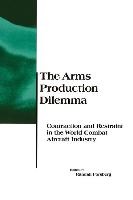Read more
In the shrinking arms market of the post-Cold War era, countries with advanced arms industries face difficult choices concerning force size, arms production, arms export, and defense industrial capacity. This book explores the links among these issues through a detailed study of the combat aircraft industries in the United States, Russia, Britain, France, Germany, Italy, and Sweden -- the seven countries that develop, produce, and export all of the worlds technologically advanced weapon systems.The studies show how military strategy, planned forces, and the age of systems in the current inventory affect the domestic demand for new production; how the recent drop in domestic demand affects arms industries; and the extent to which governments and firms in the arms-producing nations are turning to exports to sustain the industries.Stunning changes in Russias combat aircraft forces, industry, and strategy are detailed here for the first time, as are expected future Russian combat aircraft exports to China. Newly compiled data also show that in the United States and Russia and globally, arms production for export will exceed production for domestic use for the first time in history, starting in 1995. Arms production is thus increasingly dominated by commercial rather than security interests.Ultimately at issue is whether governments will exploit the opportunity offered by the dramatic post-Cold War contraction of the world arms market to reduce their armed forces and constrain international arms trade while shrinking the arms industry -- or keep pushing arms exports that generate new threats and justify larger armed forces, more arms production, and bigger arms industries.
List of contents
INTRODUCTION: Competitive Arming or Co-operative Arms Control?, Randall Forsberg; RUSSIA: Russian Air Strategy and Combat Aircraft Production: A Russian Air Force View edited and with a commentary by Alexei Arbatov, The Conversion of the Russian Military Aircraft Industry, Alexander Ozhegov, Russian Aerospace Exports, Sergei Kortunov, with a commentary by Alexei Arbatov; OTHER PRIMARY ARMS PRODUCERS: U.S. Airpower and Aerospace Industries in Transition, Randall Forsberg, Andrew Peach, and Judith Reppy, The British Push for the Eurofighter 2000, Susan Willett, Michael Clarke, and Philip Gummett, Italy's Aerospace Industry and the Eurofighter 2000, Marco De Andreis and Giulio Perani, Germany - The Reluctant Eurofighter Partner, Ulrich Albrecht, Peter Lock, and Jonathan Cohen, The Rafale and French Military-Industrial Autonomy, Francois Chesnais, Claude Serfati, and Andrew Peach, The Gripen and Sweden's Evolving Defense Industrial Policy, Elisabeth Skons and Fredrik Wetterquist; SECONDARY ARMS PRODUCERS AND MAJOR IMPORTERS: The Spread of Advanced Combat Aircraft, Jonathan Cohen and Andrew Peach; GLOBAL PROSPECTS: Issues and Choices in Arms Production and Trade, Randall Forsberg and Jonathan Cohen; Appendix, Jonathan Cohen and Andrew Peach.
Summary
The studies show how military strategy, planned forces, and the age of systems in the current inventory affect the domestic demand for new production; how the recent drop in domestic demand affects arms industries; and the extent to which governments and firms in the arms-producing nations are turning to exports to sustain the industries.

